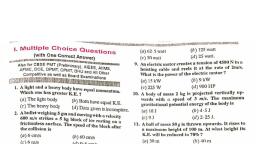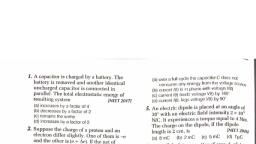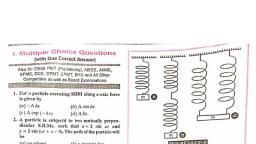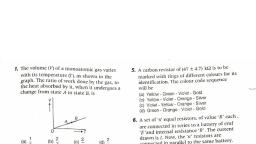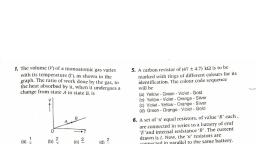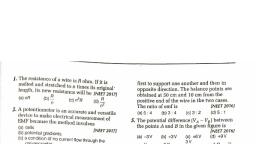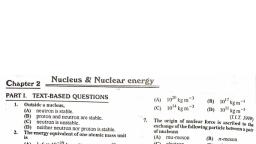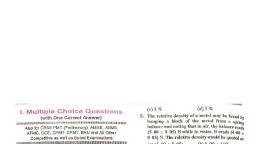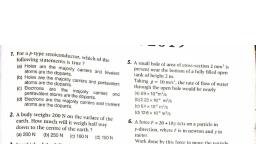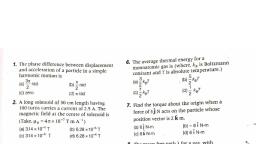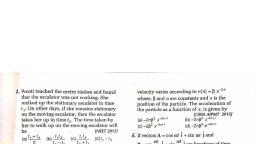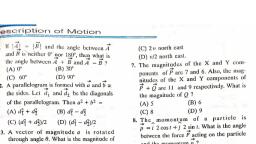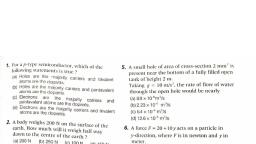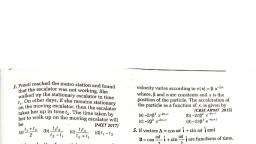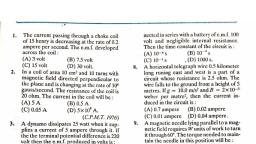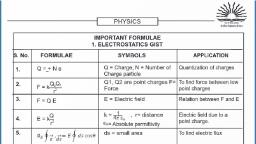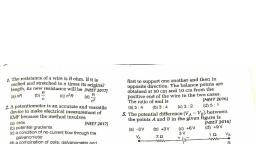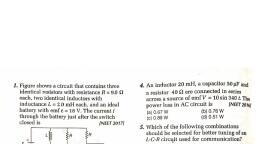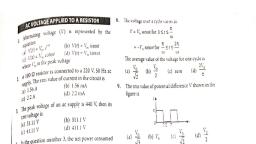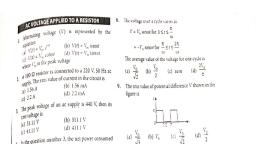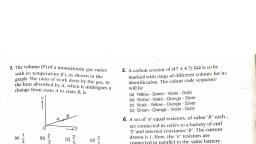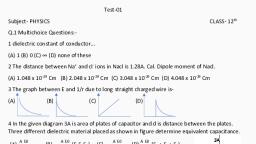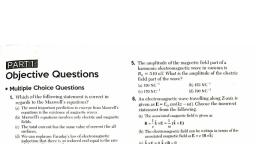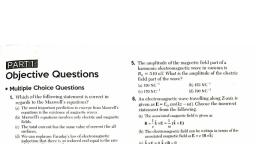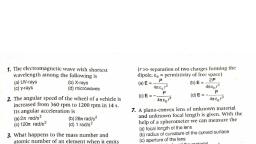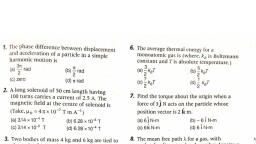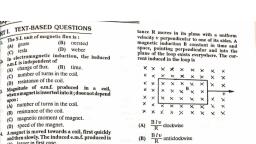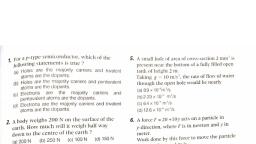Page 1 :
ic © tor of, 8. Across a metallic conduc, non-uniform cross-section, a constant, potential difference is applied. The, quantity which remain constant along the, , conductor is [CBSE AIPMT 2015], densi (b) current, o ae (d) electric field, , 9. Two metal wires of identical dimensions, are connected in series. Ifo, and, are the, conductivities of the metal wires !, respectively, the effective conductivity of, , the combination is [CBSE AIPMT 2015], (a) 2% o> (b) G+ Sp, G, + 52 26,62, (y= 82 (oy 122,, G6, 52 O, +O,, , 10. A circuit contains an ammeter, a battery of, , 30 V and a resistance 40.8 © all connected, in series. If the ammeter has a coil of, resistance 480 Q and a shunt of 20 Q, then, reading in the ammeter will be, , [CBSE AIPMT 2015], , (a05A (b)0.25A (c)2A (d)1A, , 11. A potentiometer wire of length L and a, , resistance r are connected in series with a, battery of e.m.f. E, and a resistance r,. An, unknown e.m.f. is balanced at a length / of, the potentiometer wire. The e.m.f. E will, , be given by [CBSE AIPMT 2015], Ley Eot Sey Fo! LE, ¢, @ 1% wart” L Oral, , 12. The resistances in the two arms of the, , meter bridge are 5 Q and R Q, respectively., When the resistance FR is shunted with an, equal resistance, the new balance point is, at 1.6 /,. The resistance R, is, , , , , , , , , , , , , , , , , , , , , , [CBSE AIPMT 2014], 2 48, Al 100-1, 8, (a)102 = (b)15Q = ()2AQ Masa, , 13., , 14,, , 15., , 16., , 17., , 18., , A potentiometer circuit has, , finding the internal cubenieat cae fon, cell. The main battery, used across the, potentiometer wire, has an emf of 2.9 y, , a negligible internal resistance. The _, potentiometer wire itself is 4 m long., , the resistance R, connected across the gi, cell, has values of (i) infinity, (ii) 9.5 s™, the balancing lengths, on the, potentiometer wire are found to be 3, 2.85 m, respectively., , The value of internal resistance of the cel], , ™ and, , is ICBSE AIPMT 2014), (a) 0.259 {b) 0.95 2, (c)059 {d) 0.752, , In an ammeter 0.2% of main current passes, through the galvanometer. If resistance of, galvanometer is G, the resistance of, ammeter will be [CBSE AIPMT 2014}, , 1 499 1 500, lm —— os oe, (a) a (b) (c) G @—6, , A wire of resistance 4Q is stretched to, twice its original length. The resistance of, , stretched wire would be [NEET 2013}, {aj2.Q (0) 4Q, {c)8Q (d) 162, , The internal resistance of a 2,1 V cell, which gives a current of 0.2 A through a, , resistance of 10 Q is {NEET 2013}, (a) 0.2Q (2) 0.52, () 082 (a) 1.02, , The resistances of the four arms P,Q,R and, S in a Wheatstone bridge are 10 Q, 30 2,, 30 Q and 90 Q, respectively. ‘The emf and, internal resistance of the cell are 7 V and, , 5 Q respectively. If the galvanometer, resistance is 50 9, the current drawn, , the cell will be [NEET 2013], (a) 1.0A (bp O.2A, (c)O.1A (d) 20A, , A millivoltmeter of 25 mV range is be, converted into an ammeter of 25 4 vl, The value (in ohm) of necessary shun! _, , will be ICBSE AIPMT, ‘a) 0.001 (0) 0.01, S 1 (@) 0.05
Page 2 :
JOM Gre cannes rary PIL (UNIT 1), , . i, , 21., , Four capacitors of 25 uF each are connected as, shown in figure. If the d.c, voltmeter reads 200, , V, charge on each plate of the capacitor is :, , , , , , , , , , , , , , , , , , , , rok | pak, Sr LJ, Ji |t, (A) 2x 107¢C (B) 5x 107C, (Cc) 2x107c (D) 5x107¢C, (CBSE. 1994), , In a charged capacitor, the energy resides, (A) on the positive plate. :, (B) on both the positive and negative charged, plates., (C) in the field between the plates., (D) around the edge of the capacitor plates., (Karnataka 2000 ; J.1,P.M.E.R. 1994), , ‘The energy stored in a capacitor of capacitance, C and potential V is given by, , a 5Cv @) ycv?, (c) ¥CV wm) cv?, (CBSE. 1996), , 7 oe pF capacitor is charged by a 50 V battery,, , Tow much electrostatic energy is stored by it?, , (A) 67% 10773 (B) 8-7 10775, (C) 13-6x1077J (D) 17-0x« 10785, (A.R.M.C. 1997), , Acapacitor of capacitance 10 uF was originally, charged to 10 V. Now, the potential difference, is increased to 20 V. The increase in potential, energy is, , (a) 4x 10747 (B) 10x 10743, (cy) 15x 10S =D) 5 x 1074), (CET. 1999), , ‘Two identical capacitors are joined in parallel,, , charged to a potential V, separated and they, , are connected in series ie. the positive plate of, , a is connected to the negative of the other,, , en,, , (A) ‘the charges on the free plates connected, together are destroyed., , (B) the charges on the free plates are, enhanced., , (C) the energy stored in the System increases,, , (D) the potential difference between, plates becomes 2 V, ; om, , (Karnataka Entrance, 1993 NCERT. 1973), , 3s,, , 27., , 29,, , 30., , an, , A 4uF capacitor is charged to 400 V. If its, plates are Joined through a resistance of 2 kQ,, then heat produced in the resistance is ;, (A) 0-165 (B) 0-325, (C) 0645 (D) 1-28], , (CBSE, 1995, 1994), Acopper slab of thickness ¢ is inserted between, the plates of a parallel plate capacitor, such, that ¢ is half of the separation between the, , lates. The ratio of the capacitances of the, Fapacitor before and after the introduction of, , ane, {ZZ oe, a, , (B) v2:1, (C) 1:¥2 (D) 1:2, , A metal foil of negligible thickness is introduced between two plates of a capacitor at the, centre. The capacitance of capacitor will be:, , (A). same (B) double, (C) half (D) Ktimes, (LLT. 1982), , A parallel plate capacitor is charged and the, , charging battery is then disconnected. If the, , plates of the capacitor are moved further apart, , by means of insulating handles,, , (A) the charge on the capacitor increases., , (B) the voltage across the plates increases., , (C) the capacitance increases., , (D) the electrostatic energy stored in the, capacitor increases. (LLT. 1987), , A parallel plate air capacitor is connected to a, , battery. The quantities charge, voltage, electric, , field = Lo ——— with capacitor, , are given by Q,,V,,E, and U, respectively,, , A dielectric slab is now introduced to fill the, , Space between the plates with battery still in, , cohnection, The corresponding quantities now, , oe Q,V,E and U are related to the previous, , (4) Q>0,, , (B) V>V,, (Cc) E>E,, , @) U>uU,, , LLT. 1985, Van de Graaff Renerator is used : ,, , (A) measure high potential difference,, (B) produce high d.c. potential,, , (C) produce high a.c, potential., , (D) compare high d.c. potential,, , (Karnataka Entrance, 1992, 1989)
Page 3 :
3., , 32., , 33., , 35., , White light is used to iuminate th,, , in a Young’s double slit ex veri two Slitg, separation between the slits isd and . The, is at a distance D (> > d) from the = Screen, point on the screen directly in front 0 :, the slits, certain wavelengths are ONe of, , Some of the missing wavelengths are Missing,, da 2, A 4=H (B) A= Fe, 2 3, © A=35 (D) A= 3a, (L1.T. 1984), , A thin slice is cut out of a glass cylinder alon, a plane parallel to its axis. The slice is wlecol, on a flat glass plate as shown in figure. The, observed interference fringes from this combination shall be, , (A) | straight., , (B) circular. { { { 1, , (C) equally spaced., , (D) having — fringe, spacing, which, increases as we, , go outwards., , (LLT. 1999), , In a Fresnel biprism experiment, the two positions of lens give separation between the slits, as 16 cm and 9 cm respectively. What is the, actual distance of separation ?, (A) 12-5cm (B) 12cm, (C) 13cm D) 14cm, , ane. 1999 ; C.BS.E- 1 ct, Which of the following is conserved, when lig, waves interfere ?, (A) Intensity (B) Energy, (C) Amplitude (D) Momentum, Colours appear on a thin soap filin 20, bubbles due to the phenomenon oe, (A) interference. (B) scattering:, (C) diffraction. (D) dispersion. 1995:, , a 7,, (CBSE. 1999; APM Jr 1990), , ~ he lly |
Page 4 :
Es mere, , 6. A wire of length 1, area of cross-section A is, hanging from a fixed support, The length of, , 41. The energy required to break one bond jp,, the wire changes to L, when mass M is, , DNA is 10°? J. This value (in €V) is nearly, , , , . (a)0.6 (0) 0.06 (0.006 yg, eek free end, The expression 42. The quantities of heat required to raise thy., Mo pth et) odulus is Mal. temperature of two solid copper spheres of, (a) — AL (o) === radii 5, and 75 (fj =1.5 4) through 1 K are in, eet Mgt, the ratio, . a 3 5, Wo (d) AL (2 5 2 @2, , 37. A short electric dipole has a dipole moment, of 16 x 10~° C-m. The electric potential due to, the dipole at a point at a distance of 0.6 m, from the centre of the dipole, situated on a p p, line making an angle of 60° with the dipole, , " ), axis is} —— =9 x10? Nm2/C? ™, 4ney, , 43. Which of the following graph represents the, variation of resistivity (p) with temperature rf, for copper?, , , , {a)200V = {b)400V_ (ce) zero - (d)50V r F, , Pp, 38. Ina guitar, two strings A and B made of ", same material are slightly out of tune and {c) » (d), produce beats of frequency 6 Hz. When, tension in B is slightly decreased, the beat, , T, frequency increases to 7 Hz. If the frequency t, , of A is 530 Hz, the original frequency of B 44, For transistor action, which of the following, will be, , statements is correct?, , , , , , , , (a) 524Hz (b)536Hz (c)537Hz (d) 523 Hz (a) Base, emitter and collector regions should have, same size., 39. An electron is accelerated from rest through (0) Both emitter junction as well as the collector, a potential difference of V volt. If the junction are forward biased., de-Broglie wavelength of the electron is (c) The base region must be very thin and lightly, 1.227 x 107 nm, the potential difference is doped., 1027V (e107) 10° 10 (d) Base, emitter and collector regions should have, ae o 1“ same dopping concentrations., 40. The solids which have the negative 4 ' , ., temperature coefficient of resistance are ° nce =n" of the following, Bohr model, (a) insulator only {a) Singly ionised helium atom (He* ), (b) semiconductors only (b) Deuteron atom, {c) insulators and semiconductors (c) Singly ionised neon atom (Ne* ), (d) metals, , (d) Hydrogen atom
